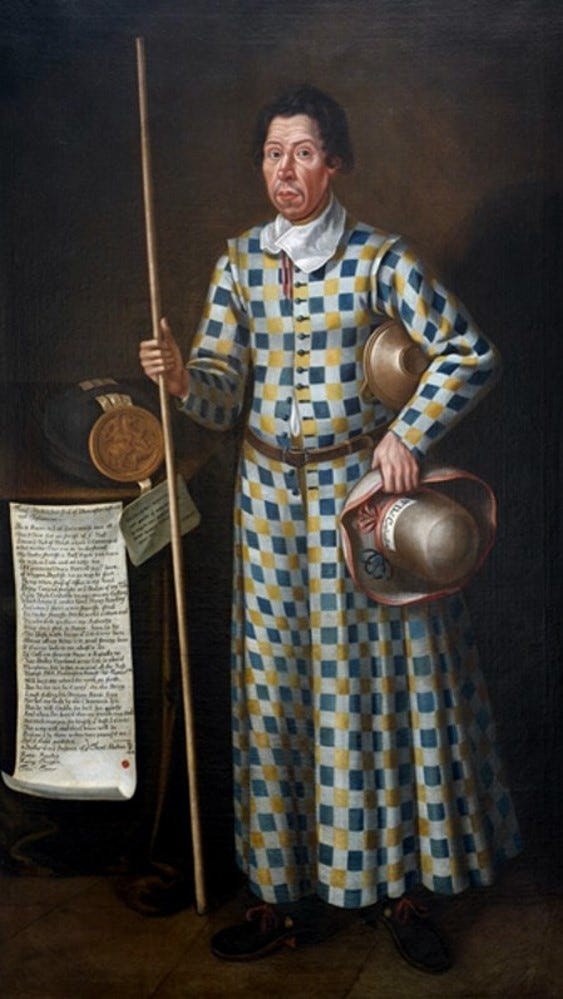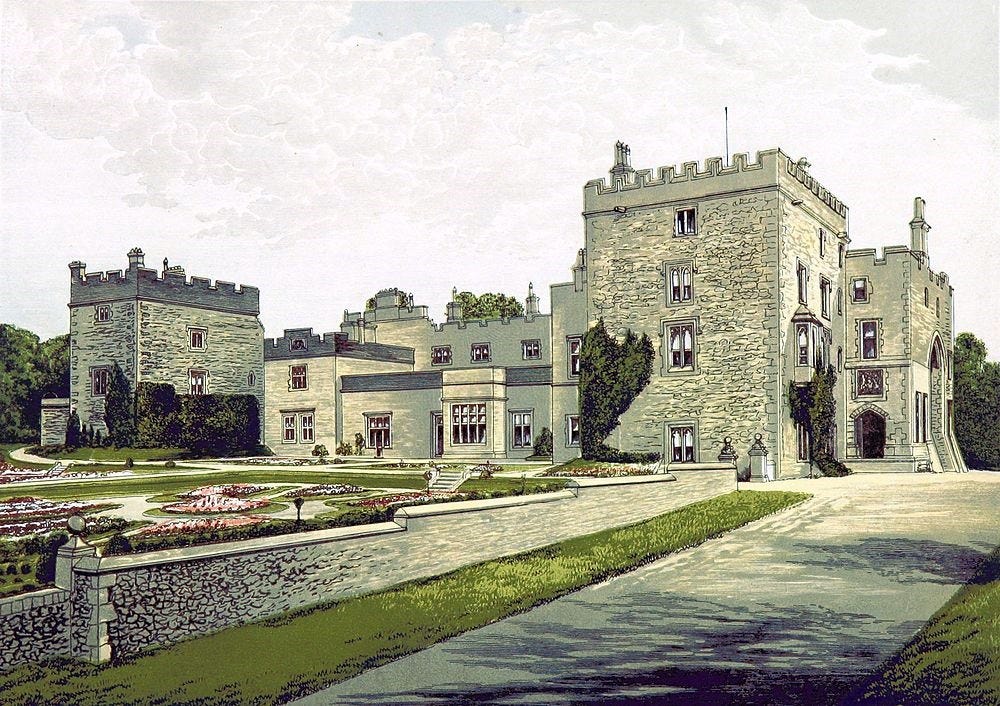The Jester of Death
Tom Skelton was a servant to the Pennington family. However he was not an obscure character in the household, but a jester, hired to inspire mirth.
But Tom was a devil disguised in the costume of a clown. Fools and jesters were often part of a royal court or noble family and by virtue of their position, could often speak harsh truths to their “betters” in the guise of drollery.

Muncaster Castle was built on the ruins of a Roman encampment located on the northwest coast of England. The vestiges of an old Roman bath was found just a few miles away in nearby Ravenglass. The state was granted to Alan de Penitone in 1208, and the Pennington family has called it home for around 800 years.
Little is known about Tom Skelton, who was hired by Sir Alan Pennington as a teacher and steward for his nephew, William Pennington who was 14 years old, when his father died and he became Lord of Muncaster Castle. However he was no ordinary servant, since a portrait was painted of him holding his last will and testament.
Skelton displayed the behavior of a psychopath, and of the worse kind which was by killing humans or putting them in harm’s way. One of his favorite diversions was to sit underneath a chestnut tree, which still stands today on the castle grounds. It is known as Thomas Fool’s Tree. It was situated next to a road frequented by travelers, and for those who asked he would offer directions. If he didn't like the person, which was probably a very high percentage, he would direct the traveler to use a road which took them to an inescapable patch of quicksand.
An unknown source told of Tom Skelton recovering the bodies, decapitating them and then burying the heads under different trees in the area. The purpose behind this was unknown, unless these were his trophies.
In 1825, John Briggs, a local journalist published an essay that described a story about the Jester of Muncastle Castle. Sir Alan Pennington had a daughter name Helwise. She attended a May Day fair in the village dressed as a shepherdess. Released from the strictures of her class due to her costume, she danced with a carpenter named Richard.
Wild Will of Whitbeck took a fancy to the mysterious shepherdess who rejected him. Little did he know that the shepherdess and the carpenter were already involved in a secret romance. He followed the couple that evening and saw when she went to Muncastle Castle, leaving no doubt to her true identity.
Like many vain and narcissistic suitors throughout history, if he could not have the object of his desire, then she would be not be with the one he had been rejected for. He knew the Sir Ferdinand Hoddleston of Millum Castle wanted to marry Helwise. Having attended Sir Ferdinand when he went on sporting excursions, he was able to gain an audience with him. He told the tale of Helwise and her secret suitor. Sir Ferdinanrd was outraged that the beautiful Helwise preferred a lowly carpenter to him, and set out the next day to visit Sir Alan.
Upon arriving at the castle, he was met by Tom Skelton who asked him why he was visiting Muncaster Castle. He said he has a grudge against Dick Carpenter, and Tom the Jester said he had one too. Sir Ferdinand promised him three crowns and protection from reprisal if he killed the man with his own axe.
Not needing much inducement to kill and be rewarded for it, Tom Skelton waited until the carpenter was taking a nap. He snuck up on him in a shed and with one blow from his axe, beheaded him. He hid the head under some wood shavings, and he was so confident of escaping punishment that he returned to the servant's hall, and told them of what he had done.
The plan backfired on Sir Ferdinand, because Helwise could only think of her dead lover and rejected him and all suitors. She ultimately went into the Benedictine Convent of Maiden Castle for the rest of her days.
Sir Ferdinand's conscience gave him no peace so he joined the army and was killed at the Battle of Bosworth Field. He left an estate to St. Mary's Abbey of Furness, with the request of prayers for his soul and that of the young carpenter.
It is unknown how many deaths Tom Skelton engineered or had a direct hand in. Sir Alan died, and the young lord of Muncaster went to live with Elizabeth Bradshaigh, his aunt and her husband Roger at Haigh Hall in Wigan.
Sometime between 1659 to 1665 Tom's first portrait was finished. The burial of a Thomas Skelton of Haigh is recorded in the Wigan parish register on January 13, 1668 (1667 Old Style), which fits with the late middle-aged look of the portrait.
When William Pennington reached his majority of age and was returning to Muncaster, another portrait of Tom the Fool was painted to be left behind with the Bradshaw family.
The "Haigh version" of the portrait, unsigned and dated, used to hang at Haigh Hall, but was sold to the Shakespeare Institute in 1957.
There is no record of Tom Skelton after 1659, so there is a possibility he died while the family was at Haigh Hall. Skelton was the last jester of Muncaster Castle and Haigh Hall. The puritans probably frowned on them, and they had fallen out of fashion with the Restoration of Charles II.
Unsurprisingly his portrait is the center of ghostly phenomena. Heavy steps and what sounds like a body being dragged up the stairs has been heard by different people. There is also the haunted Tapestry room that was previously used as a children's nursery. Visitors spending the night there, hear children crying. Some believe it is the ghost of Margaret Pennington who was a young child when she died of screaming fits in the 19th century. There are also reports of a woman singing.
Another Muncaster Castle ghost is a White Lady is thought to be Mary Bragg who was a housekeeper, or local girl who was murdered in 1805. There are different versions as to why she was killed, but it's believed a rival for the affection of a footman inspired a plan to permanently remove Mary out of the picture. She was duped into leaving with two men who said her lover was ill. They took her to a lonely spot, killed her and dumped her into the Esk River. Eventually her badly decomposed body was found. It's said she haunts the grounds and roads around Muncaster.
Skelton’s will predicted his own death in the very same quicksand he was rumored to have sent many travelers to die at. It hangs from a table to his right (the viewer’s left) on the portrait. The will reads as follows:
Thoms. Skelton late fool of Muncaster last will and Testament
Be it known to ye, oh grave and wise men all,
That I Thom Fool am Sheriff of ye Hall,
I mean the Hall of Haigh, where I command
What neither I nor you do understand.
My Under Sheriff is Ralph Wayte you know,
As wise as I am and as witty too.
Of Egremond I have Burrow Serjeant beene,
Of Wiggan Bailiff too, as may be seen
By my white staff of office in my hand,
being carried straight as the badge of my command:
A low high constable too was once my calling,
Which I enjoyed under kind Henry Rawling;
And when the Fates a new Sheriff send,
I’m Under Sheriff prick’d World without end.
He who doth question my authority
May see the seal and patten here ly by.
The dish with luggs which I do carry here
Shews all my living is in good strong beer.
If scurvy lads to me abuses do,
I’ll call ’em scurvy rogues and rascals too.
Fair Dolly Copeland in my cap is placed;
Monstrous fair is she, and as good as all the rest.
Honest Nich. Pennington, honest Ths. Turner, both
Will bury me when I this world go forth.
But let me not be carry’d o’er the brigg,
Lest falling I in Duggas River ligg;
Nor let my body by old Charnock lye,
But by Will. Caddy, for he’ll lye quietly
And when I’m bury’d then my friends may drink,
But each man pay for himself, that’s best I think.
This is my Will, and this I know will be
Perform’d by them as they have promised me.
Sign’d, Seal’d, Publish’d, and Declared in the presence of
HENRY RAWLING
HENRY TROUGHTON
THS. TURNER
THS. SKELTON, X his Mark






